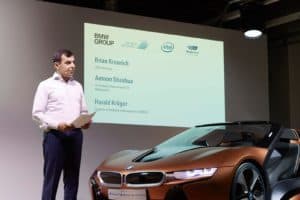 BMW Group, Intel and Mobileye are creating an open autonomous platform, from door locks to the data center. At a news conference today, Brian Kranich from Intel, Amonon Shasua from Intel and Harald Krüger made the announcement. This is the day after the first death while Autopilot was engaged in a Tesla S using Mobileye technology.
BMW Group, Intel and Mobileye are creating an open autonomous platform, from door locks to the data center. At a news conference today, Brian Kranich from Intel, Amonon Shasua from Intel and Harald Krüger made the announcement. This is the day after the first death while Autopilot was engaged in a Tesla S using Mobileye technology.
Harald Krüger, chief executive of BMW, acknowledged the Tesla autopilot death saying it was “really very sad.” He also said BMW would need “the next few years” to perfect its self-driving system.
BMW Group, Intel and Mobileye are collaborating for highly and fully automated driving into series production by 2021.
Together with Intel and Mobileye, the BMW Group will develop the solutions and systems for highly and fully automated driving by 2021. The BMW iNEXT model will be the foundation for BMW Group’s autonomous driving strategy.
BMW Group, Intel and Mobileye are convinced that automated driving technologies will make travel safer and easier.
The goal of the collaboration is to develop future-proofed solutions that enable the drivers to not only take their hands off the steering wheel, but reach the so called “eyes off” (level 3) and ultimately the “mind off” (level 4) level transforming the driver’s in-car time into leisure or work time. This level of autonomy would enable the vehicle, on a technical level, to achieve the final stage of traveling “driver off” (level 5) without a human driver inside. This establishes the opportunity for self-driving fleets by 2021 and lays the foundation for entirely new business models in a connected, mobile world.
The common platform will address level 3 to level 5 automated driving and will be made available to multiple car vendors and other industries who could benefit from autonomous machines and deep machine learning.
The companies have agreed to a set of deliverables and milestones to deliver fully autonomous cars based on a common reference architecture. Near term, the companies will demonstrate an autonomous test drive with a highly automated driving (HAD) prototype. In 2017 the platform will extend to fleets with extended autonomous test drives.